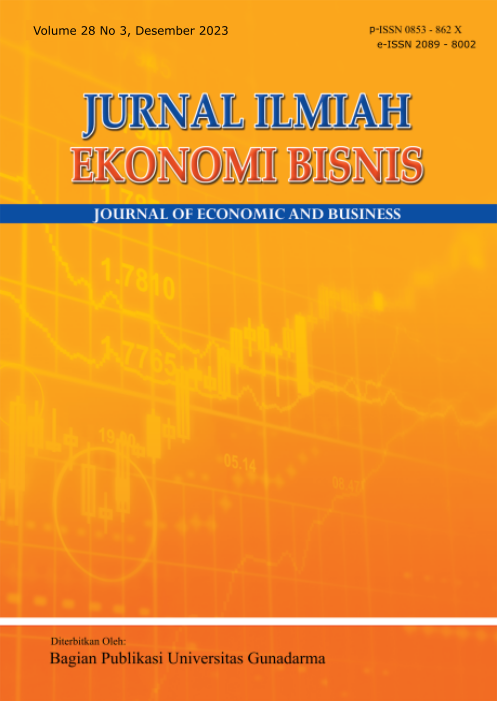PURCHASE INTENTION GENERASI Z PADA PRODUK KOSMETIK DENGAN TEKNOLOGI AUGMENTED REALITY PADA MASA PANDEMI
Atma Jaya Catholic University of Indonesia
Indonesia
Abstract
Adaptasi teknologi augmented reality selain memberikan pengalaman tersediri bagi konsumen dalam berbelanja yang direpresentasikan secara virtual dan membantu untuk mendapatkan detail informasi sebelum memutuskan membeli produk. Tidak semua retail, menerapkan teknologi ini ke dalam aplikasi mereka padahal adaptasi teknologi ini memberikan pengalaman untuk meningkatkan kecenderungan membeli (purchase intention). Penelitian disusun untuk melihat bagaimana teknologi augmented reality memberikan pengaruh terhadap keputusan membeli dengan melibatkan adanya perasaan positif yang timbul sebagai suatu response terhadap adaptasi teknologi dan bagaimana motivasi hedonic shopping motivation memberikan pengaruh didalamnya. Hasil pengolahan data terhadap 100 responden generasi Z menunjukkan bahwa penggunaan teknologi augmented reality mempengaruhi keputusan membeli dan berpengaruh terhadap perasaan positive affective response. Namun, perasaan positif yang muncul setelah menggunakan teknologi justru tidak dipengaruhi oleh hedonic shopping behavior sebagai suatu perasaan yang muncul sebagai suatu motivasi berbelanja karena didasarkan adanya motif hedonic ketimbang kebutuhan utilitarian. Hasil penelitian ini berkontribusi terhadap strategi pemasaran retail terhadap generasi Z bahwa adaptasi teknologi augmented reality mempengaruhi purchase intention namun motivasi berbelanja didasarkan keputusan secara cognitive, khususnya pada masa pandemi
Keywords
References
Azuma, R. T. (1997). Survey of augmented reality. Presence.Teleoperators and Virtual Environments, 6(4):355-385. doi: 10.1162/pres.1997.6.4.355
Babin, B. J., Darden, W. R., & Griffin. M. (1994). Work and/or fun: measuring hedonic and utilitarian shopping value. Journal of Consumer Research, 20(4), 644-656. doi: 10.1086/209376.
Bleier, A., Harmeling, C. M., & Palmatier, R. W. (2018). Creating effective online customer experiences. Journal of Marketing, 83(2), 1-22. doi: 10.1177/0022242918809930.
Chang, H.J., Eckman, M., & Yan, R.N. (2011). Application of the stimulus-organism-response model to the retail environment: the role of hedonic motivation in impulse buying behavior. The International Review of Retail, Distribution and Consumer Research, 21(3), 233-249. doi: 10.1080/09593969.2011.578798
Dacko, S. G. (2017). Enabling smart retail settings via mobile augmented reality shopping apps. Technological Forecasting and Social Change, 124(2017), 243–256. doi: 10.1016/J.TECHFORE.2016.09.032
Dodds, W.B., Monroe, K.B., & Grewal, D. (1991). Effects of price, brand, and store information on buyers’ product evaluations. Journal of Marketing Research, 28(3), 307-319. doi: 10.2307/3172866.
Ehab, M., Adel, R., & Abdelmoaty, H. (2020). The effect of augmented reality applications on customer’s purchase intentions. International Journal of Advanced Scientific Research and Management, 5(11), 34-43. doi: 10.36282/IJASRM/5.11.2020.1777.
Esmark, C. L., Noble, S. M., Bell, J. E., & Griffith, D. A. (2015). The effects of behavioral, cognitive, and decisional control in co-production service experiences. Marketing Letters, 27(3), 423–436. doi: 10.1007/s11002-015-9348-z.
Fan, X., Chai, Z., Deng, N., & Dong, X. (2020). Adoption of augmented reality in online retailing and consumers’ product attitude: a cognitive perspective. Journal of Retailing and Consumer Services, 53(3), 1-10. doi:10.1016/j.jretconser.2019.101986.
Faust, F., Roepke, G., Catecati, T., Araujo, F., Ferreira, M. G.G., & Albertazzi, D. (2012). Use of augmented reality in the usability evaluation of products. 18th World Congress on Ergonomics-Designing a Sustainable Future, 41(1), 1164-1167. doi: 10.3233/wor-2012-0298-1164.
Gao, Y.; Koufaris, M. (2006). Perceptual antecedents of user attitude in electronic commerce. Data Base for Advances in Informaton Systems, 37(2-3), 42–50. doi:
1145/1161345.1161353
He, Z., Wu, L., & Li, X. (R). (2018). When art meets tech: the role of augmented reality in enhancing museum experiences and purchase intentions. Tourism Management, 68(2018), 127–139. doi: 10.1016/j.tourman.2018.03.003
Heller, J., Chylinski, M., de Ruyter, K., Mahr, D., & Keeling, D. I. (2019). Let me imagine that for you: transforming the retail frontline through augmenting customer mental imagery ability. Journal of Retailing, 95(2), 94–114. doi: doi/10.1016/j.jretai.2019.03.005.
Hilken, T., Heller, J., Chylinski, M., Keeling, D. I., Mahr, D., & de Ruyter, K. (2018). Making omnichannel an augmented reality: the current and future state of the art. Journal of Research in Interactive Marketing, 12(4), 509-523. doi: 10.1108/JRIM-01-2018-0023.
Huang, T.L., & Liu, F. H. (2014). Formation of augmented-reality interactive technology’s persuasive effects from the perspective of experiential value. Internet Research, 24(1), 82-109. doi: 10.1108/IntR-07-2012-0133.
Hair, J. F., Ringle, C. M., & Sarstedt, M. (2011). PLS-SEM: indeed a silver bullet. Journal of Marketing Theory and Practice, 19(2), 139-151. doi: 10.2753/MTP1069-6679190202.
Hwang, J. , Yoon, Y. S., & Park, N. H. (2011). Structural effects of cognitive and affective reponses to wen advertisements, website and brand attitudes, and purchase intentions: the case of casual-dining restaurants. International Journal of Hospitality Management, 30(4), 897-907. doi: 10.1016/j.ijhm.2011.01.011.
Indrawati, P. D. (2015). Metode penelitian manajemen dan bisnis konvergensi teknologi komunikasi dan informasi. Bandung: PT Refika Aditama.
Javornik, A. (2016). Augmented reality: research agenda for studying the impact of its media characteristics on consumer behaviour. Journal of Retailing and Consumer, 30(2016), 252-261. doi: 10.1016/j.jretconser.2016.02.004.
Khan, H., & Sriram. (2019). Role of augmented reality in influencing purchase intention among millenials. Journal of Management, 6(6), 37-46. doi: 10.34218/JOM.6.6.2019.005.
Kowalczuk, P., Siepmann, C., & Adler, J. (2021). Cognitive, affective, and behavioral consumer responses to augmented reality in e-commerce: a comparative study. Journal of Business Research, 124(2021), 357-373. doi: 10.1016/j.jbusres.2020.10.050.
McGuire, W. (1974). Psychological motives and communication gratification. In J.F. Blumer & Katz (Eds.), The uses of mass communication: Current perspectives on gratification research (pp.106-167). Beverly Hills, CA: Sage.
Moon, J., Chadee, D. and Tikoo, S. (2008). Culture, product type, and price influences on consumer purchase intention to buy personalized products online. Journal of Business Research, 61(1), 31-39. doi:10.1016/j.jbusres.2006.05.012.
Mari, M., Poggesi, S. (2011). Servicescape cues and customer behavior: a systematic literature review and research agenda. The Services Industries Journal, 33(2), 171–199. doi: 10.1080/02642069.2011.613934.
Nincarean, D., Alia, M. B., Halim, N. D. A., & Rahman, M. H. A. (2013). Mobile augmented reality: the potential for education. Procedia - Social and Behavioral Sciences, 103(November 2013), 657–664. doi:10.1016/j.sbspro.2013.10.385.
Osatuyi, B. & Qin, H. (2018). How vital is the role of affect on post-adoption behaviors? an examination of social commerce users. International Journal of Information Management, 40(2018), 175-185. doi:10.1016/j.ijinfomgt.2018.02.005.
Peck, J., & Wiggins, J. (2006). It just feels good: customers' affective response to touch and its influence on persuasion. Journal of Marketing, 70(4), 56-69. doi:10.1509/jmkg.70.4.56.
Rosenkrans, G. (2009). The creativeness and effectiveness of online interactive rich media advertising. Journal of Interactive Advertising, 9(2), 18–31. doi:10.1080/15252019.2009.10722152.
Sarstedt, M., Ringle, C., & Hair, J. (2017). Partial Least Squares Structural Equation Modeling. Handbook of Market Research. Retrieved from: https://www.researchgate.net/publication/319669432_Partial_Least_Squares_Structural_Equation_Modeling.
Sasmita, J., & Suki, N. M. (2015). Young consumers' insights on brand equity. International Journal of Retail and Distribution Management, 43(3), 276-292. doi:10.1108/IJRDM-02-2014-0024.
Suh, K. S., & Lee, Y. E. (2005) The effects of virtual reality on consumer learning: An empirical investigation. MIS Quarterly, 29(4), 673–697. doi:10.2307/25148705.
Sweeney, J., Soutar, G.N., & Johnson, L.W. (1999). The role of perceived risk in the quality-value relationship: a study in a retail environment. Journal of Retailing, 75(1), 77-105. doi:10.1016/S0022-4359(99)80005-0.
Sugiyono. (2019). Metode penelitian kuantitatif dan R&D. ALFABETA. Bandung: Indonesia
Unni, R., & Harmon, R. (2007). Perceived effectiveness of push vs pull mobile location based advertising. Journal of Interactive advertising, 7(2), 28–40. doi: 10.1080/15252019.2007.10722129.
Vonkeman, C., Verhagen, T., & Dolen van, W. M. (2017). Role of local presence in online impulse buying. Information and Management, 54(8), 1038-1048. doi: 10.1016/j.im.2017.02.008.
Watson, A., Alexander, B., & Salavati, L. (2018). The impact of experiential augmented reality application on fashion purchase intention. International Journal of Retail and Distribution Management, 48(4), 433-451. doi:10.1108/IJRDM-06-2017-0117.
Yim, M. Y. C., Chu, S. C., & Sauer, P. (2017). Is augmented reality technology an effective tool for E-commerce? an interactivity and vividness perspective. Journal of Interactive marketing, 39(1), 89-103. doi: 10.1016/j.intmar.2017.04.001.
Zanger, V., Meißner, M., & Rauschnabel, P. A. (2022). Beyond the gimmick: how affective responses drive brand attitudes and intentions in augmented reality marketing. Pyschology and Marketing, 39(7), 1285-1301. doi: 10.1002/mar.21641.
Zhang, J., Liu, T. C., Sung, Y. T., & Chang, K. E. (2015). Using augmented reality to promote homogeneity in learning achievement. Proceeding of Conference: 2015 International Symposium on Mixed ans Augmented Reality-Media, Art, Social Science, Humanities and Design (pp 1-5). National Taiwan University.


